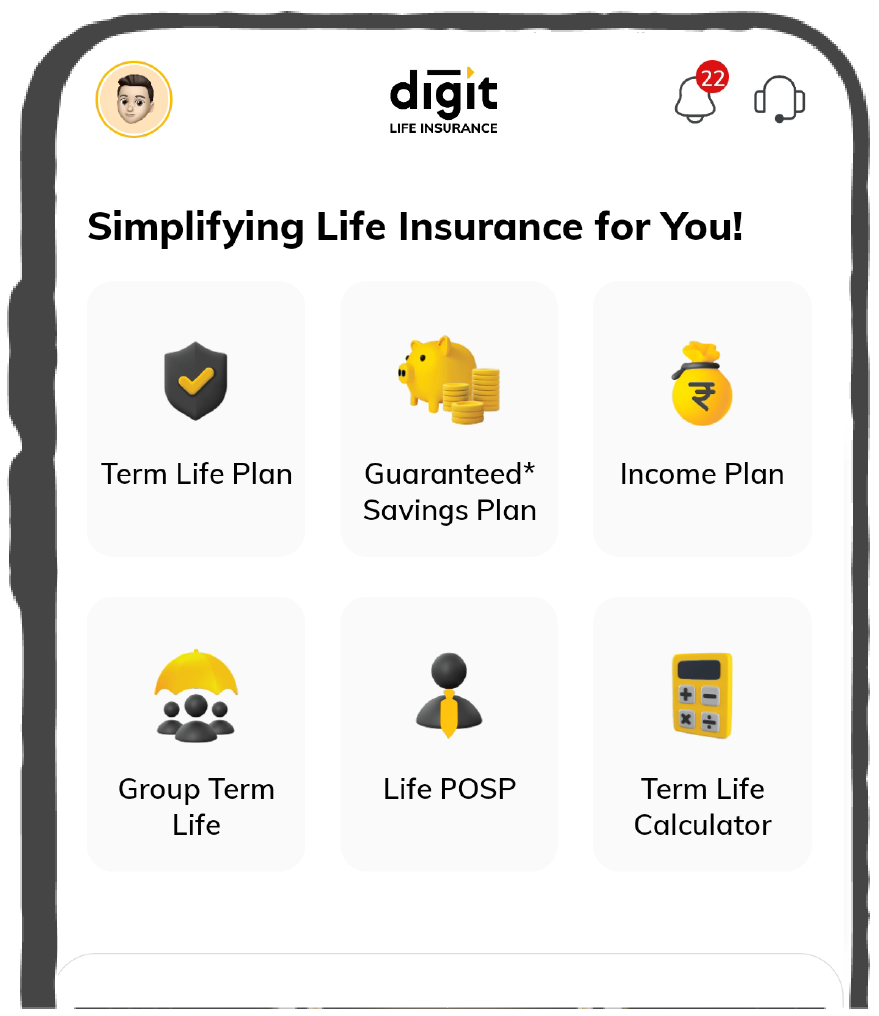Term Insurance with Critical Illness Cover
In today's unpredictable world, securing the future of our loved ones is paramount. As we navigate life's uncertainties, term insurance with critical illness cover emerges as a powerful safeguard against unforeseen challenges.
With its dual protection, term insurance with critical illness cover offers financial security and peace of mind, shielding loved ones from the potentially devastating financial impact of unexpected events, such as untimely death or debilitating critical illnesses.
What is Critical Illness Cover?
A Critical Illness Cover is an additional feature that can be added to your insurance policy. It offers financial support in the event of the policyholder being diagnosed with a critical illness specified in the policy.
While term insurance provides a death benefit, the critical illness rider provides a lump sum payout if the insured person is diagnosed with a covered critical illness during the policy term.
This payout can help cover medical expenses, loss of income and other financial burdens associated with the illness, allowing individuals to focus on recovery without worrying about the financial strain.
By opting term insurance with a critical illness benefit, individuals can proactively protect themselves and their families from the financial impact of critical illnesses.
Illustration
To understand the importance of a Critical Illness Cover, lets see the below case:
Last month Mr Rajesh was diagnosed with Cancer. He was advised of certain rounds of chemotherapies along with many medications. Being from a lower middle-class family and the sole breadwinner, it was difficult for him to arrange the entire treatment cost, amounting to almost 25 lacs, wherein his health insurance coverage was just 5 lacs.
Finally, trying to arrange the funds and make ends meet, he breathed his last within just 3 weeks after diagnosis. After his death, his family received an amount of 1 crore as proceeds from a term plan that he had purchased in time.
Where did he go wrong?
Nobody can foresee an illness or death approaching, but we can definitely plan to handle them better. There is no guarantee that he could have been saved, yet his treatment would have been handled much better with financial cover for his illness, and who knows, he might have just survived and lived for dog years with his family.
However, that did not happen.
Hence, a Critical Illness Cover is one of the most crucial riders that should be added to a Term Plan. It acts as an Income Replacement plan and ensures that the treatment of the policyholder, as well as the finances of the family, are not hit because of the illness.
How Term Plan with Critical Illness Cover Works?
Term insurance with a critical illness cover combines the benefits of traditional term insurance coverage with added protection against critical illnesses.
Let's understand how it works with an example:
Mr. Sinha had purchased a term insurance policy with a sum assured of ₹1 Crore for a term of 20 years. He also added a critical illness rider to it . The rider specified that if he was diagnosed with any of the covered critical illnesses during the policy term, a lump sum payout of ₹25 Lakhs will be triggered.
10 years into the policy term, Mr. Sinha was diagnosed with Cancer. As per the terms of the policy, he received the lump sum payout of ₹25 Lakhs, that took care of the expensive chemotherapies and other treatments. It also provided support to his dependent family at such a difficult time to manage their day-to-day expenses.
Unfortunately, even after all the treatment, Mr. Sinha couldn't be saved and succumbed to Cancer. His nominee received the total Sum Assured of ₹1 Crore as the death benefit.
Thus, a term insurance with critical illness benefit can ease the burden of medical expenses and ensure that you and your family have the necessary resources to navigate through challenging times.
What are the Benefits of Term Insurance with Critical Illness Cover?
Financial Protection Against Insured Events
Term insurance with critical illness cover offers invaluable financial protection against insured events. In the unfortunate event of the policyholder's untimely demise, it ensures a lump sum payout to the nominee, providing much-needed financial support. An additional critical illness cover offers a lump sum amount to tackle medical expenses and related costs.Acts as an Income Replacement
A Critical Illness Rider pays you the sum assured as soon as the critical illness is detected. This amount can be put to any use. In cases where the policyholder loses their ability to work and earn a livelihood, this payout can serve as an Income replacement.Coverage for Medical Expenses
Critical Illnesses come unannounced and often bring along a lot of medical expenditure. Not all of this is covered by health insurance, given its limitations. For such cases, the payout from Critical Illness Riders can be a great benefit since it can be used anywhere without restriction.Double Tax Benefit
With a Critical Illness Rider, you enjoy a double tax benefit. Your base term plan premium is tax free under Section 80C of Income Tax. The additional premium you pay towards this Rider comes under the 80D tax rebate.Lump Sum Benefit
Tem Insurance with critical illness cover offers financial protection not just in case of death but also in critical illness. In the event of a critical illness diagnosis, policyholders receive a one-time lump sum amount, providing much-needed financial support to cover medical expenses, treatment costs, and other financial obligations.Increase in Survival Chances
Having term insurance with a critical illness rider can significantly increase your chances of survival by removing financial barriers to the best possible treatments.
The lump sum payout received upon diagnosis can be utilized to access advanced medical treatments, second opinions, or seek specialized healthcare facilities. By ensuring timely and quality medical care, this coverage enhances your chances of overcoming critical illnesses and achieving a successful recovery.
Who Should Buy a Critical Illness Cover?
With increasingly sedentary lifestyles and irregular food habits, our bodies have become prone to illnesses. Hence, it is advised for everyone to add Critical Illness Cover to the term plan.
However, its importance varies from one person to the other depending on their stage of life, lifestyle, liabilities etc.
Single and Unmarried Person
Critical illnesses can strike anyone irrespective of age or gender. A critical illness benefit goes a long way to aid the complete and the best possible medical treatment. A single unmarried person might have liabilities like loan EMIs or dependent parents that might get hit if they suffer from any severe ailment and their earnings are affected.
In such a case, a critical illness benefit takes care of not just the treatment of the policyholder but also the other financial requirements.
The Breadwinner of the Family
The single earner of any family has lots of financial liabilities to cater to. When this person gets affected by any severe illness, the family suffers not just the trauma of their illness but also finances.
A critical illness benefit ensures that the children’s fees, loan EMIs and all other financial liabilities are taken care of while the policyholder undergoes treatment and takes their time for recovery.
Likewise, any such person whose finances might suffer if they fall critically ill must add a Critical Illness Rider or a Critical Illness Cover to their base term plan.
Things To Consider When Buying A Term Insurance With Critical Illness Cover
Here are a few things to consider when buying term insurance with Critical Illness Cover:
- Illnesses Covered: Check your insurance provider’s list of critical illnesses. The benefit amount payable is dependent on the critical illness cover chosen.
- Inflation: When deciding the coverage, consider the inflation rate. Ever-rising inflation pushes medical costs considerably every year.
- Waiting Period: A Critical Illness policy usually has a specific waiting period after which it comes into force. This waiting period differs across insurance providers and may range from weeks to years. Select the one that has a minimum waiting period and comes into effect as early as possible.
- Treatment Costs: Medical expenses and treatment costs keep rising every day. Critical illnesses are furthermore expensive. It is imperative to research the cost of treatment for significant diseases and accordingly plan your coverage.
- Coverage for the Recovery Period: Most critical illnesses require a lengthy recovery period. As a thumb rule, assume the recovery period as 5 years and get enough coverage to take care of your finances for that period.
- The Benefit Amount Payable: The benefit amount payable is equal to the critical illness cover that the policyholder has chosen.
Term insurance with Critical Illness Cover acts as a comprehensive safety net, providing financial support and peace of mind during challenging times. As you explore insurance options, consider your specific needs, compare policies, and consult with insurance professionals.
This will help you find the right term insurance plan with a critical illness rider that suits your requirements and offers robust protection for you and your loved ones.
FAQs about Term Insurance with Critical Illness Cover
What are the Exclusions of Critical Illness Insurance Cover?
The Exclusions of a Critical Illness Policy are:
- Any listed critical illness diagnosed before the stipulated waiting period is completed.
- Pre-existing disease
- Illness due to a congenital defect
- Any intentional injury
- Any illness/injury because of drugs or alcohol
- Injuries or illnesses caused due to war, terrorism, criminal or unlawful acts by the life assured
- Underwater or any adventurous activity
What is the Waiting Period for Critical Illness Benefit?
What is the Survival Period?
If I Claim Once, Can I Renew my Critical Illness Benefit?
How Much Critical Illness Cover Should I Opt for in my Term Insurance Policy?
Is the Premium for Term Insurance with Critical Illness Cover Higher than Regular Term Insurance?
Can I Add a Critical Illness Rider to an Existing Term Insurance Policy After the Policy is Issued?
Can I Claim the Critical Illness Benefit More than Once if I am Diagnosed with Multiple Critical Illnesses?
Is a medical check-up required to avail a critical illness rider?
Other Important Articles Related to Term Insurance










